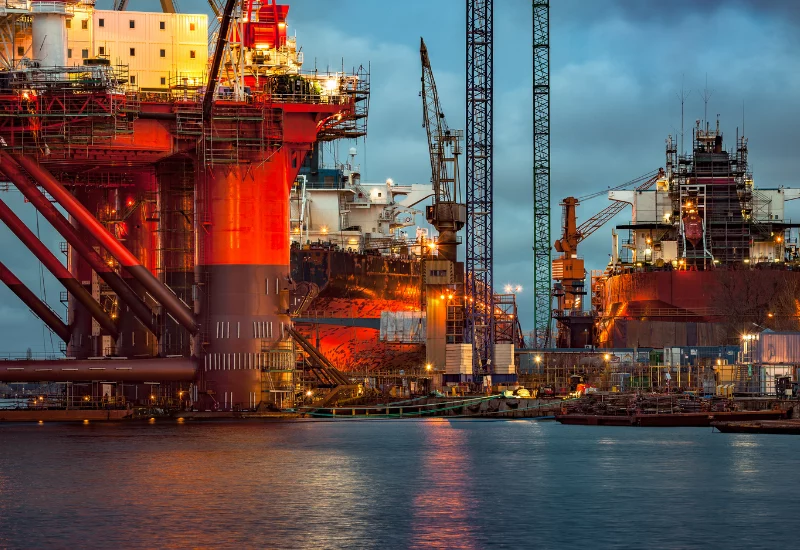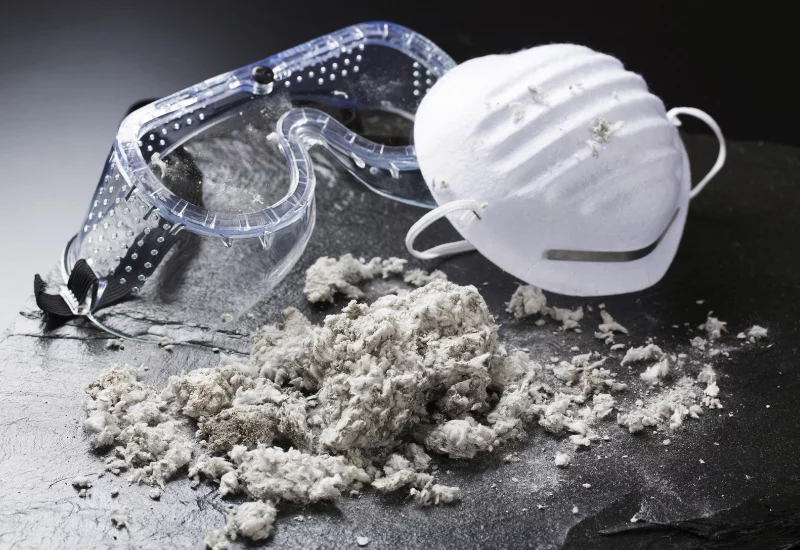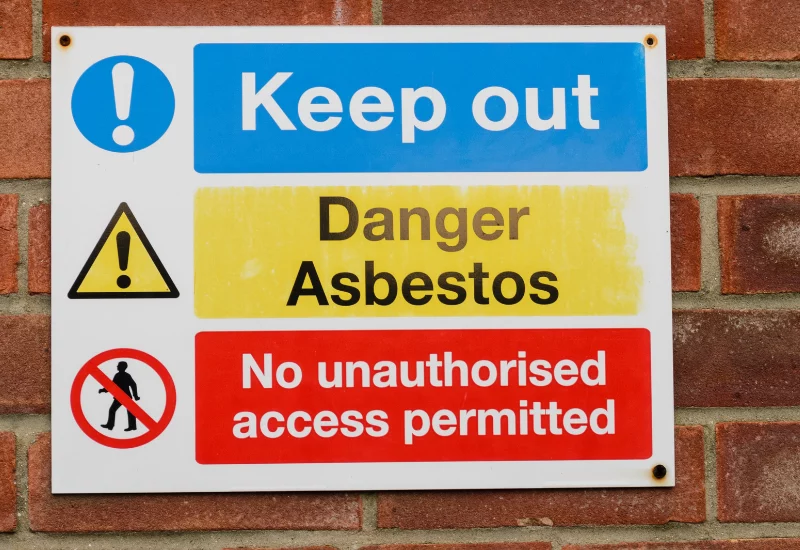- 23 Feb 2022
- •
- 6 min read
Portsmouth, Southampton and Isle of Wight shipyard workers exposed to asbestos

Asbestos was heavily used in shipyards throughout the UK during the 1950’s, 1960’s and 1970’s.
Despite clear instructions about the dangers of asbestos being given from the government to the shipyards in 1945 it was still commonplace for asbestos to be found within shipyards and dockyards for decades afterwards. The import and use of all types of asbestos in the UK was finally banned in 1999.
Within the shipyards asbestos was used mainly as an insulator for boilers, pipe work and between compartments within the ships’ deckheads and bulkheads. Asbestos was present as insulation in ships being built, re-fitted, repaired or decommissioned in shipyards through Hampshire.
Due to the fact that asbestos can break apart into tiny fragments resembling dust it was not only people who worked directly with asbestos who were at risk from breathing in the dangerous particles but also other workers in the vicinity. Warnings about the dangers of asbestos were rarely passed onto workers and no protective clothing or equipment provided.
If you or someone you know has developed an asbestos related illness after asbestos exposure in a shipyard in Portsmouth, Southampton or the Isle of Wight a asbestos claim for compensation may be possible. To find out if we can help you on a cost-free basis, call us on 023 8082 0526.
Am I entitled to make a claim for an asbestos-related illness?
Can I claim asbestos compensation?
Claiming compensation after developing an asbestos-related disease can seem daunting and the laws around who is entitled to claim can seem confusing. If you are in any doubt as to whether you can claim, we would always recommend you seek legal advice. Below are some of the most common questions we are asked concerning exposure to asbestos in shipyards.
Can I claim if the Shipyard I worked for is no longer trading?
Some shipyard workers who contact us worry that if their former employer who exposed them to asbestos is no longer trading that they won’t be able to claim compensation. This is rarely the case as the claim for compensation is made against the insurance company covering the firm at the time rather than the employer therefore, we simply contact the insurer.
At Trethowans we have a long history of fighting for the rights of workers exposed to asbestos and have built up a large database containing details of many of the employers who exposed their workers to asbestos and details of their insurers.
Can I claim if I worked for more than one shipyard who exposed me to asbestos?
Another common worry is that it will be impossible to claim compensation if you worked for lots of different companies over the years who all exposed you to asbestos. We have helped many people in this situation, and it does not always cause problems to have had a lot of different employers.
Can I claim if I worked for the MOD?
If you were a member of the Armed Forces employed at the Naval Dockyard when you were exposed to asbestos, you may still be able to make a claim for compensation.
If the exposure was after 1987 (when the Crown Proceedings Act removed the “Crown Immunity”, which prevented Military Personnel from making personal injury compensation claims against the Ministry of Defence), you will be entitled to make a claim. This would be dealt with in the same way as a civilian would make a claim against their employer.
If the exposure was before 1987, you would not be able to make a personal injury compensation claim; however, you may be entitled to claim a War Pension or a make a claim under the Armed Forces Compensation Scheme.
Can I claim if I was exposed to asbestos many years ago?
For personal injury claims involving asbestos related illnesses, you have 3 years from the date you are diagnosed with an illness rather than 3 years from the date you were exposed to the asbestos.
The reason for this is that asbestos related illnesses take many years to develop. The time between exposure and illness is known as the ‘latency period’ and can be a short as 10 years to as long as 50 years.
Can I claim if the person who had the illness has already died?
It is sometimes the case that a health problem is not diagnosed until very shortly before a person dies and in some cases is not diagnosed until a post mortem examination is carried out.
In addition to this, it is not always someone’s main priority to make a claim for compensation when they have only just been diagnosed with a serious health problem and in some cases, they pass away before getting around to seeking legal advice.
For this reason, the usual 3-year time limit for making a claim for compensation begins from the date of the person’s death to allow their family time to claim (except where the limitation expired before death).
Asbestos Related Illnesses suffered by Shipyards Workers
Examples of Asbestos Related Diseases suffered by Dockyard workers
There are a number of different illnesses which can be caused by exposure to asbestos. Some produce more serious health problems but none of them are reversible.
Asbestosis is probably the most well-known of all the asbestos related illnesses and tends to only affect people who have had a heavy exposure to asbestos over a prolonged period of time. If you worked in a shipyard for a number of years with asbestos dust in your working environment, then you could be at risk of developing asbestosis.
Pleural Thickening is another asbestos related disease caused by asbestos fibres causing scarring and thickening to the lining of the lungs which can create breathing difficulties. There is also a similarly named condition called Pleural Plaques, but compensation is not currently available for pleural plaques in England following a House of Lords decision in 2007.
Mesothelioma is the most serious asbestos-related disease and is always fatal, often leaving sufferers with only a few months to live after diagnosis. Mesothelioma can develop after fairly minimal exposure to asbestos, therefore workers employed at a shipyard or dockyard for only a short period of time could be at risk of this illness.
Asbestos lung cancer can be caused by heavy doses of asbestos. Smoking and asbestos exposure combined can multiply the risks of developing lung cancer to a considerable extent.
If you or someone you know has been diagnosed with any of these conditions and were exposed to asbestos while working at a shipyard or dockyard, a personal injury claim for compensation may be possible. To discuss the individual circumstances of your case and find out if we can help on a cost-free basis, call us on 023 8082 0526.
About Shipyards in Portsmouth, Southampton and the Isle of Wight
Portsmouth Southampton and the Isle of Wight are located on the South coast of England. These areas have easy access into the English Channel and were seen as an ideal location for dockyards, shipbuilders and ship-repairers.
Portsmouth Southampton and the Isle of Wight have strong maritime histories and shipbuilding and ship-repairers have provided a great deal of employment in the area over the years.
Shipyards in Portsmouth
In Portsmouth, the HM Royal Navy Dockyard is one of the oldest dockyards in the world, founded over 500 years ago. Throughout the 18th, 19th and 20th century the dockyard flourished and was one of the largest in the world building battleships, cruisers and frigates.
As well as being a place of work for military personnel, the Royal Dockyard also employed civilian workers and outside contractors.
Shipyards in Gosport
Across the harbour from the HM Royal Navy Dockyard in Portsmouth is the town of Gosport where a shipyard called Camper & Nicholson Limited was situated. The company specialised in building Royal Navy vessels and not to be confused with a company with the same name that built yachts in the town.
Shipyards in Southampton
Harland and Wolff had a shipyard in Southampton for a time although they are probably more well-known for their shipyards in Liverpool or in Belfast where Titanic was built.
Another Shipyard in Southampton was Day, Summers & Co.
Possibly the most well-known shipyard in Southampton, however, is Vosper Thornycroft (UK) Limited which was formed as a result of a merger in 1966 of Vosper Ltd of Portsmouth and JI Thornycroft of Southampton. The company was nationalised in 1977, becoming a division of British Shipbuilders but became a commercial company again after a management buyout in 1985.
Shipyards on the Isle of Wight
The largest shipyard on the island was operated in East Cowes by J Samuel White & Company Limited. The company specialised in building vessels for the Royal Navy for much of the twentieth century, until the 1960s.
Although all of the shipyards mentioned above provided welcome employment in the Hampshire area, they also exposed a lot of workers to asbestos as part of the shipbuilding process.
For expert ‘no win no fee’ legal advice from our dedicated and knowledgeable team of asbestos and pleural thickening solicitors, contact John Hall at Trethowans today on 023 8082 0526.


